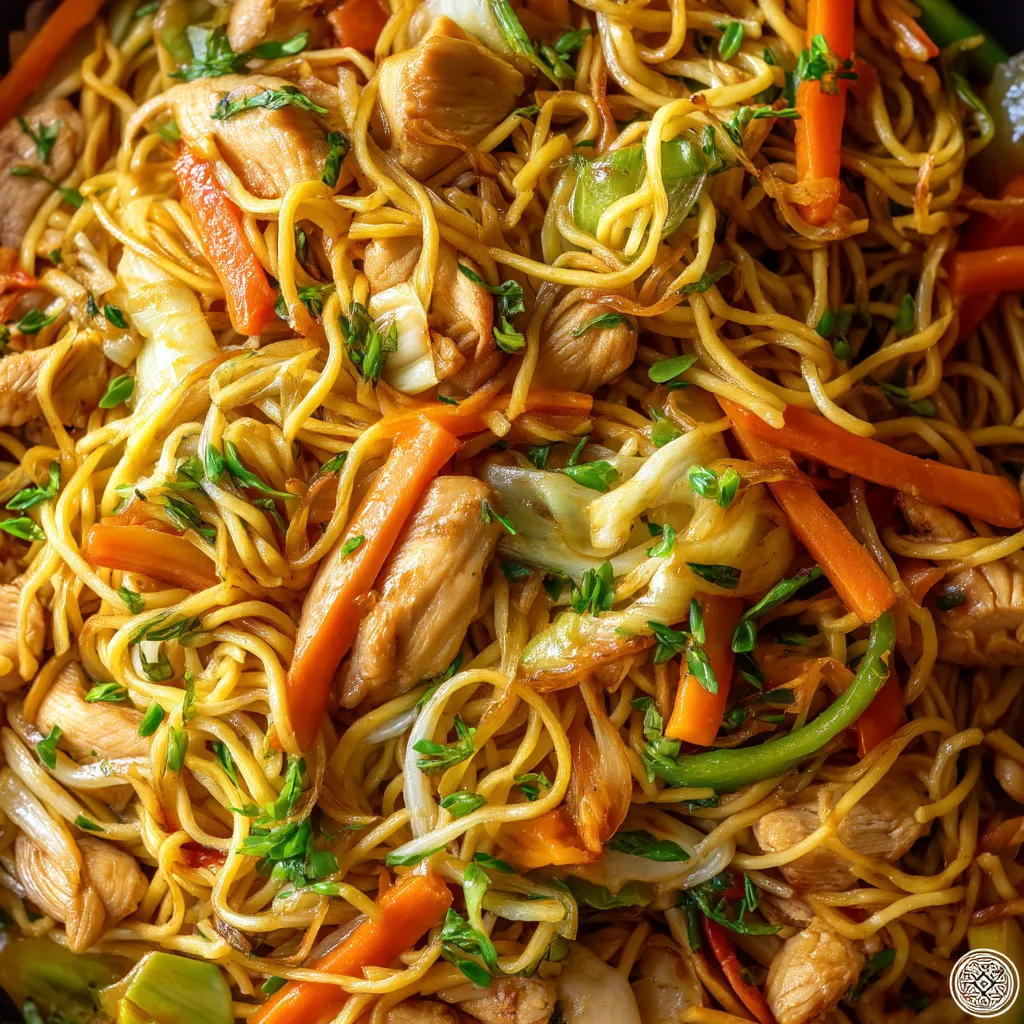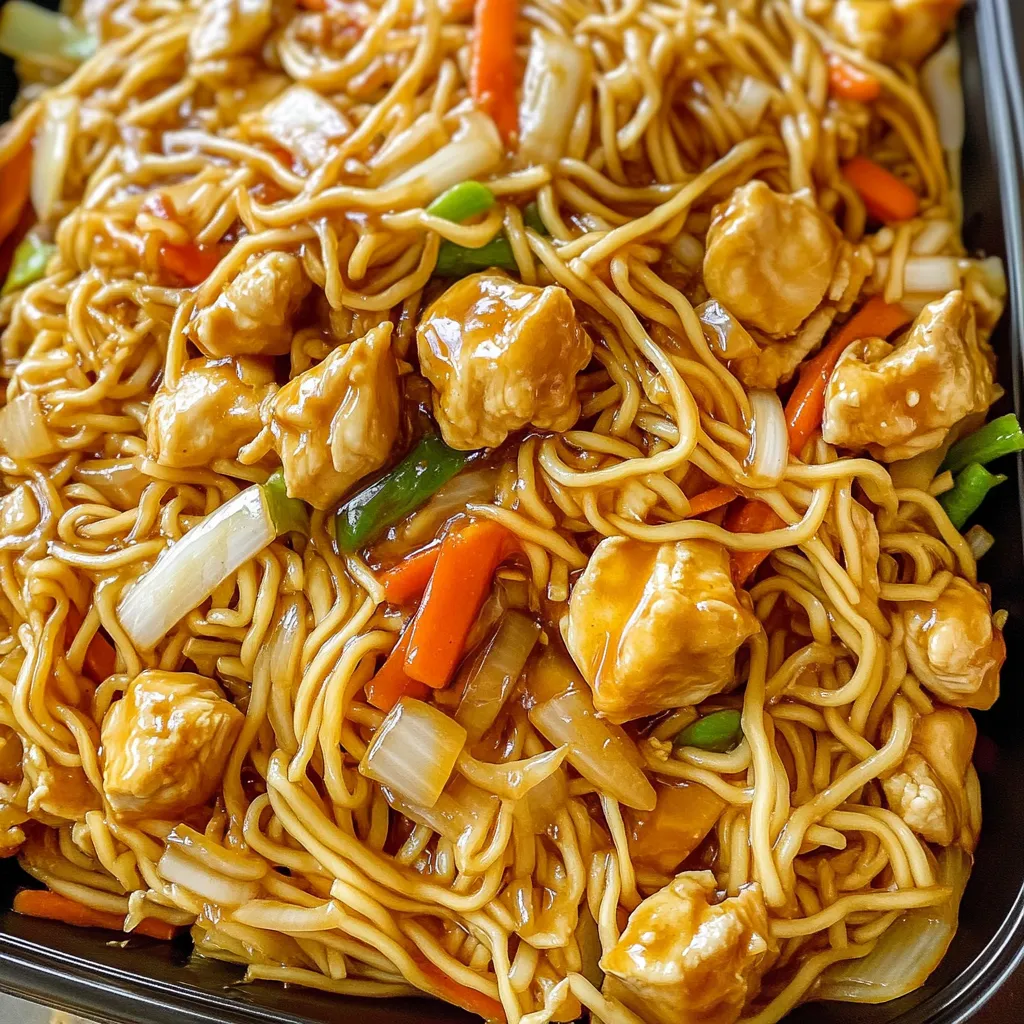 Pin
Pin
This chicken chow mein transforms humble ingredients into a restaurant-quality dish that rivals any takeout I've ever had. The homemade sauce is the true star here with its perfect balance of savory and slightly sweet notes that coat every strand of noodle and morsel of chicken.
I developed this recipe after spending way too much money on mediocre takeout chow mein. After several test batches and sauce adjustments my family now requests this version instead of ordering in.
Ingredients
- Chicken breast the lean protein becomes tender and juicy when cooked quickly at high heat
- Chow mein noodles look for fresh ones in the refrigerated section for best texture
- Cabbage adds essential crunch and sweetness when slightly cooked
- Carrots provide natural sweetness and beautiful color contrast
- Green onions offer a mild onion flavor that perfectly finishes the dish
- Garlic infuses the entire dish with aromatic flavor
- Oyster sauce the secret ingredient that gives authentic restaurant flavor
- Low sodium soy sauce adds umami without making the dish too salty
- Light sesame oil adds subtle nutty flavor without overpowering
- Chicken broth creates a silky sauce that clings to every noodle
- Cornstarch thickens the sauce to the perfect consistency
- Granulated sugar balances the savory elements with just enough sweetness
Step-by-Step Instructions
- Prepare the Sauce
- Whisk together all sauce ingredients until completely smooth with no cornstarch lumps. This balanced sauce is what makes this chow mein special so take your time mixing it properly. The sauce should look glossy and somewhat thick even before cooking.
- Cook the Noodles
- Follow package instructions exactly since different brands require different cooking times. The key is to slightly undercook them as they will continue cooking when added back to the wok. Rinse immediately with cold water to stop the cooking process and prevent sticking.
- Cook the Chicken
- Heat your oil until it shimmers but doesn't smoke. Cut chicken into even strips so they cook uniformly. Spread them out in the pan and let them develop a golden crust before stirring. This creates flavor and ensures juicy chicken.
- Sauté the Vegetables
- Cook the carrots first as they take longer then add cabbage and garlic. The vegetables should maintain some crispness while the cabbage becomes slightly translucent. This textural contrast is essential to authentic chow mein.
- Combine and Finish
- When adding everything back to the pan work quickly to combine all elements with the sauce. Keep the heat medium high and toss constantly to ensure even sauce distribution. The finished dish should have a glossy appearance with the sauce clinging to all components.

My grandmother always said the secret to good chow mein is in the wok hei that special flavor that comes from cooking quickly over high heat. While a traditional wok is ideal any large pan with enough surface area will work beautifully.
Make Ahead Options
This dish comes together quickly but you can prepare several components ahead of time to make dinner even faster. The sauce keeps well in the refrigerator for up to three days in an airtight container. You can also slice all the vegetables and chicken up to a day before cooking. Store everything separately in the refrigerator in sealed containers. The noodles should be cooked fresh for the best texture.
Vegetable Variations
The beauty of chow mein is its adaptability to whatever vegetables you have available. Bell peppers add wonderful sweetness and color. Snow peas or sugar snap peas provide a satisfying crunch. Mushrooms particularly shiitake add tremendous umami depth. Bean sprouts are traditional and add fantastic texture when added in the final minute of cooking. Whatever vegetables you choose aim for a variety of colors and textures for the most satisfying result.
Serving Suggestions
Chicken chow mein is a complete meal on its own but pairs beautifully with simple sides for a more elaborate meal. Serve alongside potstickers or spring rolls for an Asian feast. A simple cucumber salad dressed with rice vinegar provides a refreshing contrast to the rich noodles. For beverage pairings jasmine tea or a light lager beer complement the flavors perfectly without overwhelming the dish.
Common Questions About This Recipe
- → Can I make chicken chow mein ahead of time?
Yes, you can prepare chicken chow mein ahead of time. Cook as directed, then cool completely before storing in an airtight container in the refrigerator for up to 3 days. To reheat, stir-fry in a hot wok with a splash of water or chicken broth to restore moisture. For best texture, consider undercooking the noodles slightly when preparing ahead.
- → What vegetables can I substitute in chicken chow mein?
Chicken chow mein is versatile and accommodates many vegetables. Good substitutions include bell peppers, snow peas, bean sprouts, bok choy, broccoli, mushrooms, or water chestnuts. Aim for a mix of colors and textures, and cut vegetables into similar sizes for even cooking.
- → Can I use different protein instead of chicken?
Absolutely! This chow mein works wonderfully with beef strips, shrimp, tofu, or pork. For beef or pork, slice thinly against the grain. For shrimp, reduce the cooking time to prevent overcooking. For tofu, press it first to remove excess moisture and consider coating in cornstarch before frying for a crispy exterior.
- → What type of noodles should I use for authentic chow mein?
Traditional chow mein uses wheat flour noodles that are slightly egg-enriched. Look for packages specifically labeled 'chow mein noodles' or 'Chinese egg noodles.' In a pinch, you can substitute with thin spaghetti or linguine, though the texture will be slightly different. For an authentic experience, fresh noodles from an Asian market are ideal.
- → Is there a way to make this dish gluten-free?
Yes, to make gluten-free chicken chow mein, use rice noodles or gluten-free spaghetti instead of wheat-based chow mein noodles. Replace regular soy sauce with tamari or gluten-free soy sauce, and verify your oyster sauce is gluten-free (or use a gluten-free oyster sauce alternative). Always check all packaged ingredients for hidden gluten.
- → How can I adjust the sauce if I don't have oyster sauce?
If oyster sauce isn't available, you can create a substitute by combining 2 tablespoons of soy sauce with 1 tablespoon of hoisin sauce and a pinch of sugar. Alternatively, fish sauce mixed with a bit of brown sugar can provide a similar umami flavor. For vegetarian options, look for mushroom-based oyster sauce alternatives which provide comparable depth of flavor.
